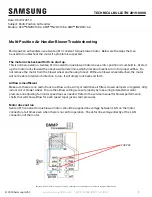
9
Pressure: The pressure of R-410A is approximately 60% (1.6 times) greater than
R-22.
Recovery and recycle equipment, pumps, hoses, and the like must have design
pressure ratings appropriate for R-410A. Manifold sets need to range up to 800 psig
high-side and 250 psig low-side with a 550 psig low-side retard. Hoses need to have a
service pressure rating of 800 psig. Recovery cylinders need to have a 400 psig service
pressure rating, DOT 4BA400 or DOT BW400.
Combustibility:
At pressures above 1 atmosphere, a mixture of R-410A and air can
become combustible.
R-410A and air should never be mixed in tanks or supply
lines or be allowed to accumulate in storage tanks. Leak checking should never
be done with a mixture of R-410A and air.
Leak-checking can be performed safely
with nitrogen or a mixture of R-410A and nitrogen.
3.1.3 QUICK-REFERENCE GUIDE FOR R-410A
• R-410A refrigerant operates at approximately 60% higher pressure (1.6 times) than
R-22. Ensure that servicing equipment is designed to operate with R-410A.
• R-410A refrigerant cylinders are light rose in color.
• R-410A, as with other HFCs, is only compatible with POE oils.
• Vacuum pumps will not remove moisture from POE oil used in R-410A systems.
• R-410A systems are to be charged with liquid refrigerants. Prior to March 1999,
R-410A refrigerant cylinders had a dip tube. These cylinders should be kept upright
for equipment charging. Post-March 1999 cylinders do not have a dip tube and should
be inverted to ensure liquid charging of the equipment.
• Do not install a suction line filter drier in the liquid line.
• A factory-approved outdoor liquid line filter drier is shipped with every unit and must
be installed in the liquid line at the time of installation. If only the air-handler is being
replaced on an existing system, the existing filter drier must be replaced at the time
of installation with a field supplied filter drier.
IMPORTANT:
A bi-flow filter drier must
be used for heat pump applications. Filter driers must be rated for minimum working
pressure of 600 psig. The filter drier will only have adequate moisture-holding capaci-
ty if the system is properly evacuated.
• Desiccant (drying agent) must be compatible for POE oils and R-410A refrigerant.
3.2 APPLICATONS
• Vertical Upflow is the factory configuration for all models (see Figure 3).
• If return air is to be ducted, install duct flush with floor. Use fireproof resilient gasket
1/8 to 1/4 in. thick between duct, unit and floor. Set unit on floor over opening.
3.2.1 MOUNTING OPTIONS
The air handler comes standard with two different options for mounting, wall mount or
frame mount. Both mounting options require the unit to be level from side to side and
from front to back in order to allow condensate to properly drain from the unit. Failure to
do this will result in condensate to leak out from the unit potentially causing structural
damage to the surrounding support structures, dry wall, carpet, etc. around the unit.
Also, both mounting structures require the ability to accommodate a minimum of 150 lb.
load. Failure to do this will cause damage to the support structure and potentially dam-
age the unit.
3.2.1.1 WALL MOUNT
The air handler comes standard with a wall mounting bracket and air handler mounting
bracket. Reference Figure 5 for more detail.
1. Remove the wall mounting bracket from the back of the unit by removing one screw
which attaches the bracket to the air handler. Note: Discard the screw after you have
removed the wall mounting bracket.
2. Install bracket one the wall by using 6 wood screws (not provided). Make sure the
bracket is level in order to provided proper drainage from the unit. Note: Do not attach
the wall mounting bracket into unsupported dry wall. Make sure that the wood screws
are going into a structure that can support a minimum of 150 lb load.
3. Lift the air handler above the wall mounting bracket and attached the unit to the
installed bracket. Reference Figure 5.
3.2.1.2 FRAME MOUNT
The air handler comes with 8 clearance holes 4 on each side. These holes are used to
mount the air handler inside of a frame structure (see Figure 6). When mounting in this
fashion, make sure that the wood screws are mounted from within the air handler and not
outside of the unit. Installing the screws from the outside could cause damage to the coil.































